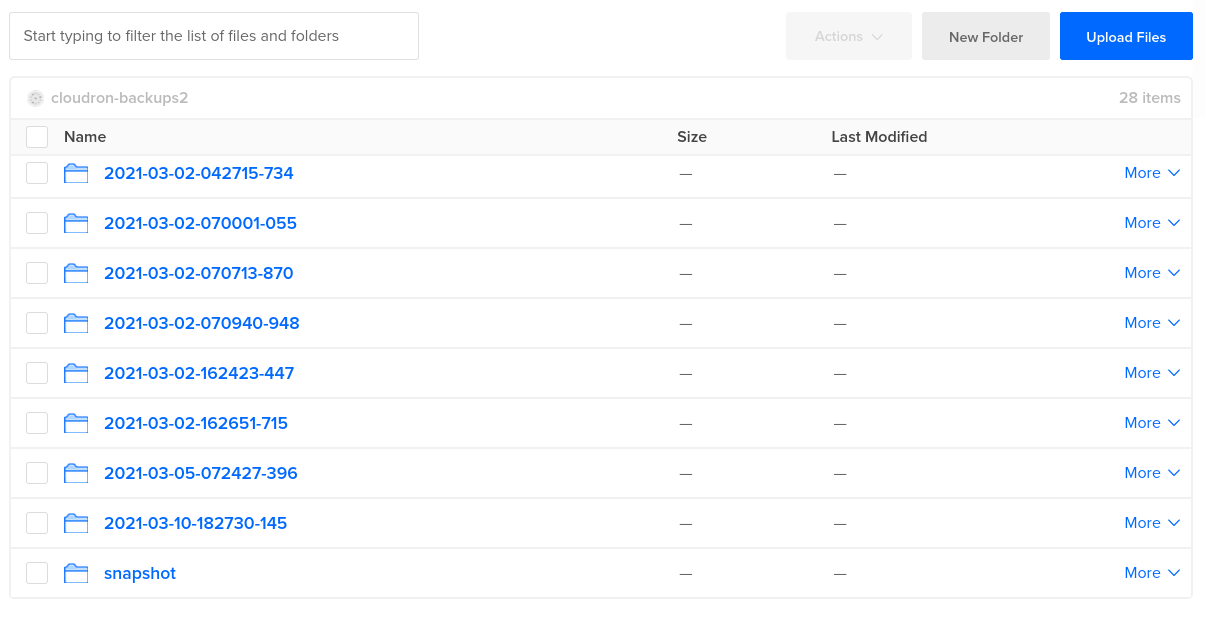Download Backups
Overview¶
In this guide, we will see how to download backups.
Backup file names¶
Backups are categorized at the top level as timestamped directories. This timestamp
indicates the time at which the backup was started. In addition, there is a directory
called snapshot. The snapshot directory is a working directory for the backup logic
and should not be touched.
Inside each timestamped directory, Cloudron stores the backup of each app individually.
These backups have the file name app_<location>_v<package_version>. When using
the tgz backup format, the file will have an extension .tar.gz. When using the rsync
backup format, this will be a directory.
Email backups are stored with the file name mail_v<box_version>.tar.gz (or without the extension
for rsync).
Cloudron stores the backup of the platform itself with the file name box_v<box_version>.tar.gz (or
without the extension for rsync).
File System¶
To download a backup when using the Filesystem provider, simply use a tool like scp.
S3 (UI)¶
If you use one of the S3 compatible providers, you can usually go to the UI of the storage provider and find the latest timestamp. For example, in DO spaces:

In the screenshot above, we can see that 2021-03-10-182730-145 is the latest. Navigate inside the directory and download the files.
S3 (AWS CLI)¶
In some cases, some S3 providers do not have a UI to the object storage or the UI may simply fail to load with many objects. We can use the S3 CLI in that case to determine the backup ID.
-
First, install the AWS CLI tool. On Linux, you can simply do
sudo apt install awscli. For other platforms, see this guide. -
List the objects using the CLI tool. Note that sometimes you have to set the
AWS_DEFAULT_REGIONto be the region name of the provider and sometimes tous-east-1. This setting depends on your provider. In the example below,cloudron-backups2is the name of the bucket. If you provided aprefix, then you must lists3://cloudron-backups2/prefixin the example below.
$ export AWS_ACCESS_KEY_ID=JWAJUADXZJU2LBPBQLG2
$ export AWS_SECRET_ACCESS_KEY=SomeSecretKeyThatCannotBePublic
$ export AWS_DEFAULT_REGION=us-east-1
$ aws --endpoint-url=https://sfo2.digitaloceanspaces.com s3 ls s3://cloudron-backups2/
PRE 2021-03-02-162423-447/
PRE 2021-03-02-162651-715/
PRE 2021-03-05-072427-396/
PRE 2021-03-10-182730-145/
PRE snapshot/
We can see above that the latest timestamp is 2021-03-10-182730-145. Now, we can list the contents of that directory.
$ aws --endpoint-url=https://sfo2.digitaloceanspaces.com s3 ls s3://cloudron-backups2/2021-03-10-182730-145/
2021-03-10 10:27:33 7129765 app_wekan.cloudron.space_2021-03-10-182732-640_v1.2.0.tar.gz
2021-03-10 10:27:34 422273 box_2021-03-10-182734-919_v6.2.3.tar.gz
Use aws s3 sync to download the file.